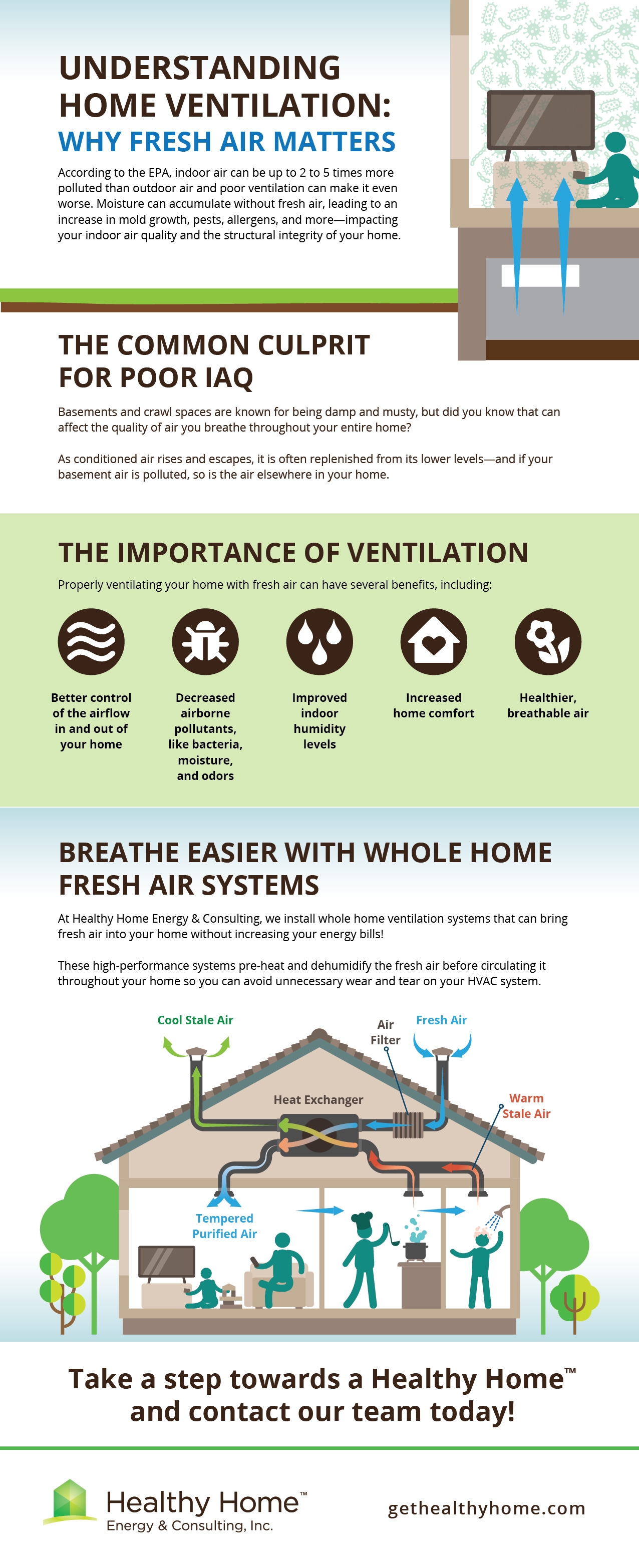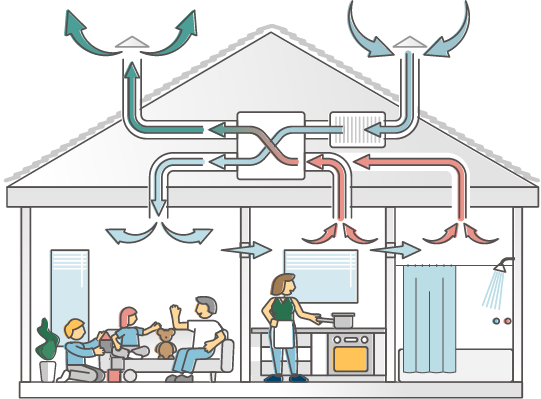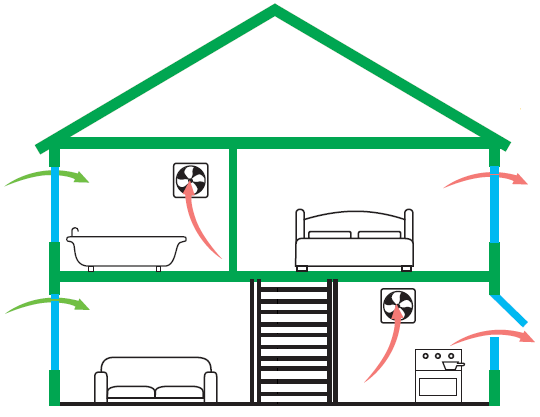Recognizing the Value of Home Ventilation for a Healthier Living Setting
Home air flow plays an important function in maintaining a healthy and balanced living environment. It helps with the exchange of exterior and interior air, which is necessary for improving air top quality. Without correct ventilation, homes can come to be reproducing grounds for pollutants and irritants. The repercussions of insufficient air circulation can be significant. This raises the query of just how home owners can efficiently carry out ventilation approaches to protect their wellness and wellness. Recognizing these approaches is imperative.

The Basics of Home Air Flow
Home ventilation functions as an important component of indoor air quality and convenience. It entails the procedure of exchanging stagnant indoor air with fresh exterior air, therefore reducing moisture and managing temperature level. Appropriate ventilation systems can consist of natural approaches, such as open windows and vents, in addition to mechanical systems, such as exhaust fans and air exchangers. Effective home air flow assists protect against issues like interior mold development and the build-up of dangerous particles. It also boosts overall energy effectiveness, as well-ventilated spaces can maintain comfortable temperature levels with much less dependence on home heating and cooling systems. Comprehending the basics of home ventilation is vital for homeowners seeking to develop a much healthier living setting for themselves and their households.

Common Resources of Indoor Air Air Pollution

Lots of may not understand it, indoor air contamination can stem from various resources within a home. Usual contributors consist of volatile organic substances (VOCs) sent out from paints, solvents, and cleansing items. Home home appliances, such as gas cooktops and fireplaces, can launch unsafe gases like carbon monoxide and nitrogen dioxide. In addition, mold and mildew flourish in moist locations, releasing spores that influence air top quality. Pet dog dander, allergen, and pollen can accumulate inside, more worsening contamination degrees. Smoking indoors produces harmful chemicals that linger in the air. Building products, including asbestos and formaldehyde, can off-gas damaging materials. Acknowledging these resources is vital for preserving a healthier interior environment and advertising effective air flow techniques.
Health Consequences of Poor Ventilation
Interior air pollution can have substantial wellness ramifications, particularly when air flow is inadequate. Poor ventilation can result in the accumulation of damaging toxins, such as unpredictable natural substances, mold, and particle matter. This accumulation might lead to respiratory system concerns, including bronchial asthma, allergies, and persistent obstructive pulmonary disease. Individuals may experience signs and symptoms like migraines, tiredness, and irritability of the eyes, nose, and throat. Susceptible populations, such as youngsters and the senior, are at greater risk for severe wellness effects. Lasting exposure to improperly aerated environments can additionally add to more serious problems, including cardiovascular illness. Subsequently, ensuring correct ventilation is essential for keeping a healthy and balanced living atmosphere and reducing the danger of health and wellness difficulties connected with interior air pollution.
Efficient Ventilation Strategies for Your Home
Proper air flow is necessary for keeping a healthy and balanced indoor environment, and implementing efficient techniques can considerably enhance air top quality. Homeowners can begin by ensuring that exhaust fans are installed in washrooms and cooking areas to get rid of excess dampness and odors. Opening up windows on a regular basis permits fresh air to distribute, particularly throughout mild weather. Additionally, utilizing air purifiers with HEPA filters can help capture air-borne pollutants. For homes with home heating and cooling systems, maintaining HVAC systems and changing filters consistently is important for peak performance. Incorporating all-natural air flow strategies, such as cross-ventilation, can likewise improve air visite site movement. Lastly, securing any kind of leaks in doors and home windows avoids undesirable drafts, which can disrupt regulated air flow, eventually leading to enhanced indoor air high quality and comfort.
Maintaining Ideal Air Quality Year-Round
To preserve ideal air quality year-round, home owners have to take on an aggressive strategy to handling their interior environment. On a regular basis keeping track of interior air quality is essential; this consists of monitoring for pollutants such as dirt, mold, and unpredictable natural compounds (VOCs) Implementing reliable air flow systems, such as exhaust fans and air cleansers, view publisher site can substantially lower airborne contaminants. In addition, routine upkeep of a/c systems warranties peak efficiency and air flow. House owners need to additionally think about moisture levels, as extreme moisture can bring about mold and mildew development. Seasonal adjustments might require changes in air flow techniques to accommodate differing outside air quality. By focusing on these practices, property owners can create a healthier space, advertising overall well-being for all occupants throughout the year.
Frequently Asked Questions
How Can I Tell if My Home Demands Much Better Air Flow?
To determine if a home requires better air flow, one should observe indicators such as consistent moisture, mold and mildew development, moldy smells, condensation on windows, or increased allergy signs, suggesting inadequate air movement and potentially bad indoor air high quality.
What Are the Signs of Poor Indoor Air Quality?

Can Houseplants Improve Indoor Air High Quality Properly?
The performance of houseplants in boosting interior air high quality is questioned. While some research studies recommend they can soak up toxins and create oxygen, their general effect might be minimal compared to proper air flow and air filtering systems.
Just how Often Should I Adjustment My Air Filters?
The frequency of air filter adjustments usually relies on use and filter kind. Typically, it is advised to replace filters every three months, though homes with pets or allergies might need more frequent adjustments for excellent performance.
Exist Any Type Of Certain Ventilation Equipments for Allergic Reaction Sufferers?
Many ventilation systems, such as HEPA-filtered systems, properly reduce allergens in the air. Home Ventilation Melbourne. These visit the website systems trap pollen, animal, and dust dander, offering allergy patients with a cleaner, healthier indoor atmosphere while handling air high quality properly
It facilitates the exchange of outdoor and interior air, which is vital for boosting air top quality. Home air flow offers as a vital element of indoor air high quality and convenience. It includes the process of exchanging stale indoor air with fresh outdoor air, thus decreasing humidity and controlling temperature. Interior air contamination can have significant health and wellness ramifications, specifically when air flow is inadequate. Proper ventilation is crucial for maintaining a healthy and balanced interior setting, and applying reliable techniques can substantially boost air quality.